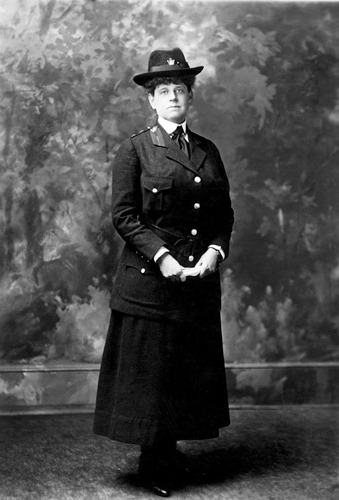Since 1943, upon a proclamation of President Franklin Roosevelt, every March is recognized at National Red Cross Month.
Did you know that a woman with ties to Boardman, Ohio helped to make the Red Cross what it is today.
Mabel Thorp Boardman, daughter of William and Florence Boardman, began her service with the American Red Cross in 1901. Her grandfather, William, was born in Boardman, Ohio on Apr. 15, 1832.
Mabel Thorp Boardman’s father was Henry Mason Boardman, a son of the founder of Boardman Township, Elijah Boardman.
Henry Mason Boardman married Sarah Benham in 1818. He set out for Ohio to manage his family’s extensive land interests in the town founded by his father. He arrived in 1819, and, feeling for the lack of organized religion, organized the St. James Episcopal Church in 1820. When a pastor was unavailable, Boardman would serve as lay reader. Eventually, he would sponsor construction of a meeting house.
The Boardman’s had one child, William, and spent the remainder of their lives in Ohio. On December 15, 1846, Henry was stepping into his carriage when his horse moved. He fell backward onto the seat, which was not fastened to the carriage, and subsequently landed on the ground. He was paralyzed from the neck down and died two days later.
Henry’s son, William, moved to Cleveland and on October 12, 1860, Mabel Thorp Boardman was born there. Her Boardman-born father, William, was a lawyer and active in politics, was the grandson of the U.S. Senator Elijah Boardman. Her mother, Florence Sheffield, was the granddaughter of Joseph Earl Sheffield, who was a major benefactor of Yale University.
Mabel Thorp Boardman was a socialite and she devoted time to many philanthropies.
During the Spanish–American War in 1898 she was active in recruiting nurses.
In 1900 her name appeared, apparently without her knowledge, as one of the incorporators on the application of the American Red Cross for a congressional charter. She accepted the involvement, secured a seat on the executive committee of the Red Cross, and began studying the work of international Red Cross groups. She quickly concluded that the leadership of the aging and autocratic Clara Barton was the root of public apathy about the Red Cross, and she began to agitate for change.
In 1901 she was elected to the Executive Board of the American Red Cross and subsequently led the faction that ousted Barton from the presidency of the organization in 1904.
Barton always took personal charge during major disasters. She gave the illusion of efficiency but was unable to build up a staff she trusted, and her fundraising was lackluster. As a result, she was forced out in 1904, when male professional social work experts took control and made it a model of Progressive Era scientific reform.
They imposed a new corporate ethos of ‘managerialism,’ transforming the Red Cross away from Barton’s cult of personality to an ‘organizational humanitarianism’ ready for expansion along increasingly professional lines.
Mabel Boardman refused formal chairmanship of the Red Cross, insisting that the occupancy of the conspicuous positions by men was necessary to retain public confidence. To that same end, she worked hard to develop support for the Red Cross among the socially prominent. By her indefatigable labors, the Red Cross accumulated a large endowment fund, established branches across the country, greatly improved its lifesaving, first aid, and other services (in part through hard-won cooperation with such groups as the American Nursing Association), and developed a readiness to respond quickly to disasters and military needs.
In 1920, President Woodrow Wilson appointed Mabel Boardman to be the first and only woman member of the Board of Commissioners of the District of Columbia.
From 1923 until 1944, Boardman served as the Director of the Red Cross’s Volunteer Service and overseeing its considerable expansion.
She died on March 17, 1946, of a coronary thrombosis in Washington D.C.
This article was republished with permission from the Boardman News.

